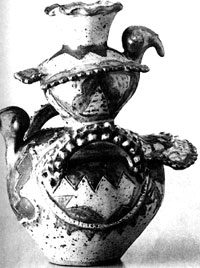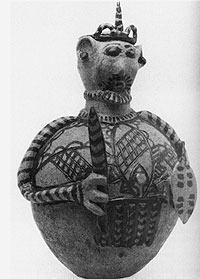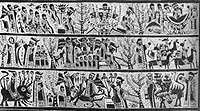As the Polly Street Art Center drew to a close so Rorke's Drift was established. Polly Street was urban, Rorke's Drift rural. If Polly Street attempted a romantic re-connection to Africa, Rorke's Drift was in Africa. If men almost exclusively dominated Polly Street, Rorke's Drift is notable for the central role of women.
The Evangelical Lutheran Church Art and Craft Centre at Rorke's Drift, Natal, was established in 1962 and had a significant impact on the development of South African art and craft in the 1960s and 1970s. This influence continues in the 1980s, through the graduated students who have filtered into many areas of South African cultural life. GraduÂates of the ELC fine art course have gone on to work as administrators and educators at virtually all of the existing art centres in the country: Lionel Davis at community Arts Project (CAP) in Cape Town, Bongi Dhlomo at the Alex Art Centre, Sokhaya (Charles) Nkosi at the Funda Centre, Soweto, Cyril Manganye at the Mofolo Art Centre, Soweto, Dumisani Mabaso at the Johannesburg Art Foundation, and many others.
The interaction between the Swedish, American and South African teachers and the black South African students at the ELC made for a complex set of artistic exchanges and cross-cultural influences. The exact nature of the influences brought to bear would obviously have varied depending on the particular teachers. However it is a recurring phenomenon that white art teachers from Europe and South Africa, working in the African context, often insist that they have imposed as little as possible and concentrated on teaching technique, 'allowing natural talent to surface'. Walter Battiss, in an article on the Centre, describes this relationship thus:
The Centre, directed since 1968 by Otto Lundbohm, is the result of a unique and successful venture in cross-cultural art and craft production - a delicate combination of Swedish technical assistance and traditional African design and skill, although it is planned that the entire operation will graduÂally be turned over to the Africans. (1) The duality of the old and the new, traditional and technological, western and African, were inscribed in the stated aims of the Centre:
To nurture the unique artistic heritage of Africa. To extend this heritage with new influences so that it will find its rightful place in an evolving and changing society.
To ensure that it develops with the changing society and that its arts and crafts will find increasingly profitable outlets. To assist in raising their standard of living by extending it's teaching influence through its students and by giving local people work and an income. (2)
The ELC Art and Craft Centre were started in 1962 by Peder and Ulla Gowenius. This arose out of a committee formed in 1961 in Stockholm, Sweden, for the advancement of African art and craft. As a result of this initiative Peder and Ulla Gowenius were sent to South Africa to work at the Ceza Mission Hospital, Zululand. Here they met Azaria Mbatha and Allina Khumalo (now Allina Ndebele) both of whom were sent to Sweden for further studies, Allina in 1964 and Azaria in 1966. During 1962 the ELC Art School Committee was formed in Natal and the ELC Art and Craft Centre was opened at Umpumulo (Mapumulo) in the same year. The purpose of its programme at this early stage was to prepare women students as art and craft advisors to work with patients in hospitals. Financially this was made possible through capital raised by an exhibition of traditional art and craft; TB patients made the work as therapy at Ceza Mission Hospital in Zululand (these included linocuts by Azaria Mbatha). The profit from this exhibition totalled R6000 and was used to give the centre its first home at Umpumulo. The Church of Sweden Mission took responsibility for the salaries of the first teachers at the centre, Peder and Ulla Gowenius.
In 1963 the Art and Craft Centre moved to Rorke's Drift and occupied some existing disused buildings: In the late 1950s Rorke's Drift farm of 5000 acres was proclaimed White Land and thus making all the people staying on the farm Squatters, and soon after the Lutheran Theological Seminary was moved to Umpumulo leaving all its buildings empty for the Church to divide between the Circuit Centre, the Emseni Old Aged Home and the ELC Art and Craft Centre. (3)
When the Art and Craft Centre moved to the empty buildings at Rorke's Drift in 1963 a loan (later repaid) of approximately R6000 was received from the Church of Sweden Mission. An exhibition in Stockholm in late 1963 enabled further funds to be generated for extensions to the existing buildings. It is extremely important to note that the financial reports up to 1971 indicate that the Centre was able to provide for many of its financial needs. It appears that substantial profits generated by the weaving section paid for the running of the school, including the fine art department and the pottery and textile printing workshops.
Looking at a summary financial report for the years 1964 to 1971, it is interesting to note that the sales of work in South Africa increased as the sales abroad decreased. However an enormous quantity of work was sold abroad, and it is therefore difficult to get a complete impression of the range of work produced. What is evident is that without the initial support from the Swedes, and the marketing of work in Stockholm and other parts of Europe and America, it would not have been possible to sustain this most important art centre.
The centrality of the weaving workshop in this process cannot be over-estimated. The manner in which this workshop developed is partially accounted for in this description by Battiss:
The leaders, Jessie Dlamini and Allina Ndebele, encourage artistic independence in each student or apprentice ... Each selects his [her] colors and creates his [her] own design: no design is ever re-used, although occasionally another artist may freely reinterpret one... The tapestries... usually incorporate figurative images based on folklore, the Bible, or important events. (4)
One of the major commissions received by the weavers workshop was a tapestry (3m x 5.5m) for the renovated Council Chambers of the Royal Society, London.
Allina Ndebele, who had been a nurse at the Ceza Mission Hospital, started as an interpreter for the Gowenius couple and went on to be trained as a weaver. She received training in Sweden and became the master weaver, directing all the teaching of learner weavers and in the words of a catalogue dedicated to her work, " establishing a weaving workshop which gave work to destitute mothers". (5)
It is important to understand the Art and Craft Centre in terms of issues of gender. To a large extent almost exclusively one or other sex practised the different art forms: weaving by women, apart from some designs by men; fine art by men, apart from a few women; and the ceramic workshop in which both men and women worked, but where two approaches developed: Dinah Molefe, with a small group of women, continued the female tradition of making pottery by the coil method; while the men, under the guidance of Gordon Mbatha, used the kick-wheel.
This issue was taken further in a distinction between 'useful' and other arts. In unpublished biographical notes by Brenda Danilowitz this dichotomy is made evident:
 Mbatha Elizabeth (b.1950)
Mbatha Elizabeth (b.1950)
Double turkey jar
Through Gowenius, [Azaria] Mbatha became interested in drawing, although this was not a technique encouraged at the centre, which focussed on the more "useful" arts such as weaving and fabric printing, practised mainly by women. In fact, in the first years of the Centre's existence, Mbatha appears to have been one of the only male artists working there. Aside from his drawing, his work at this time also involved creating designs for tapestries, which were woven by the women and for which the centre soon achieved great fame. (6)
However this notion of 'usefulness' did not prevent the ceramicists from experimenting with new forms. All the ceramics produced are stoneware and although a great deal of the work produced is functional, there are examples of work, in particular by Dinah Molefe and Elizabeth Mbatha, that use the basic vessel shape to produce purely sculptural forms. This practice has continued to evolve at the Katlehong Art Centre, where two ex-Rorke's Drift artists, Bhekisani Manyoni and Ephraim Ziqubu have worked for the past decade. Manyoni too has used the ceramic vessel as the starting point for sculptural works depicting warthogs. When one compares the art with the craft produced at the Centre there appears to have been a consistent sharing and borrowing of imagery. Artists produced designs for tapÂestries and participated in the ceramics workshops. Azaria Mbatha designed tapestries; Ziqubu produced ceramics, linocuts and designed a tapestry that was sent to the Sao Paulo Biennale in 1973. The ongoing interaction between the school, where fine art was taught, and the workshops, where craft was produced, was an important phenomenon in the history of South African art.
 Molefe Dinah (b.c.1918 or 1927)
Molefe Dinah (b.c.1918 or 1927)
Pottery figure - traditional Zulu man
Looking at the history of the art school, one can possibly argue that there were two distinct phases. The first period, that of the 1960s, witnessed the evolution of a number of significant talents. All developed as printmakers, using relief (lino) and intaglio (etching) techniques: Azaria Mbatha, John Muafangejo, Cyprian Shilakoe and Vuminkosi Zulu. Shilakoe and Zulu also produced sculpture in wood. The primary focus on graphic techniques can be partly accounted for in terms of Gowenius 'insistence that' usefulness ' should inform all activities. Graphics are easily translated into illustrations, designs for fabrics and mass-produced and inexpensive images. Gowenius introduced the lino technique and in so doing echoed an existing style that had already been developed amongst local artists. As noted in the previous chapter one needs only to look at the relief carvings in wood of Tivenyanga Qwabe, made from as early as the 1920s, to see how the lino technique represented an extension of an already existing style. There appear to be some close parallels in the development of Mbatha and Muafangejo, particularly in their early works. However Muafangejo's work always retains looseness and a quality of dynamic movement, spontaneity and a searching for the image, whereas Mbatha employs a far more careful and less varied cutting technique:
Inspired by stories from the Old and New Testaments, Mbatha creates a highly decorative and intricately detailed arrangement of horizontal and vertical narrative scenes in his linocuts that are markedly African in temper. (7)
What these artists have in common is their own particular interpretation of the context, the social and religious environment of the art school. Mbatha produces the most specifically Christian imagery, while Muafangejo's work, at first religious in content, develops into an explicitly social commentary. Shilakoe is intensely engaged with a philosophical and mystical portrayal of the human condition.
Mbatha illustrated biblical stories, bringing to them a particularly African context:
Azaria Mbatha's The Birth of Jesus is a departure from the conventional nativity scenes which usually bombard us each Christmas. Here we have a bald, bearded Joseph, a lion and King Herod lurking in the jungle behind the three wise men who are on an elephant. Not only do we have a second elephant but a bushpig as well... We are unmistakably in Africa. We are made to view the nativity through fresh eyes. (8)
 Mbatha Azaria (b.1941)
Mbatha Azaria (b.1941)
The revelation of St. John, c. 1965
Muafangejo was less concerned with the illustration of biblical text and much more engaged with the social, persona] and environmental reality of the world that surrounded him. All the important experiences in his life are graphically recorded and accompanied by explanatory texts describing the exact nature of the event recorded. He does this without any loss to the visual form of the work.
Shilakoe, who died tragically at the age of 26, is generally less well known than Mbatha and Muafangejo. His work is rich in symbolism and addresses social and psychological anguish in a highly personalized idiom. He makes use of the etching technique to good effect so as to create images of great mystery and pathos. He had a close friendship with Dan Rakgoathe, a fellow student at the Centre. Rakgoathe, in a short memoriam to Shilakoe, describes his work thus:
Cyprian's talents were a blend of artistic as well as spiritualistic gifts... his source of inspiration was unreal; he set his eyes on, e.g. the transient drifts of clouds across the infinite sky, the swaying ghostly trees in the caressing breeze, splash spots on careÂlessly painted walls, linen flapping desperately in the violent wind... all these gave him inspiration... (9)
The images of agony, loneliness and desolation are given a haunting presence through the use of etching and aquatint. This technique was ideally suited to the vision of Shilakoe, enabling him to make images grow out of and become submerged into the surroundings. The stark contrast of tonality, associated with the lino technique, could never have conveyed the same sense of mystery. Although his work carries no overt symbols of protest it is implicitly engaged in a representation of the many hardships endured by his people:
 Shilakoe Cyprian Mpho (1946 - 1972)
Shilakoe Cyprian Mpho (1946 - 1972)
Follow the footsteps, you will find her sleeping, 1970
However, he was not only concerned with abstract idealism, but the everyday suffering of his own people had some impact upon him. He saw and felt the suffering of his own people at being victims of a political system beyond their own control. (10)
By the early 1970s these three artists had all moved on and a new generation of artists and teachers arrived. Muafangejo returned as 'artist in residence' in 1974 and stayed for a few years. The second phase of the Centre during the 1970s is marked less by the development of any major individual talents than by the attempt to establish the school on a sounder educational basis. Although this might not have been successful, the course provided obviously laid significant foundations, enabling many of the students to find success in a number of art related fields in the 1980s.
However it would appear that pressures relating to resources and a high turnover of staff in the school, led to the decision finally to close the fine art section in 1982.
The closure of the fine art school came as a great shock to many people in the art education field. The reasons for this closure need to be researched. It appears that there was a tension between the fine art section and the craft section. This may have had to do with finance given that the fine art section was subsidised by the craft section. The fine art students tended by and large to come from the urban areas whereas the crafts producers were generally rural people. The fine art section seems to have cost the church money whereas the crafts section generated income. The fine artists, particularly the generation of the post 1976 era, were arguably quite different in terms of their level of political consciousness and viewed the operation of the school far more critically. It would appear furthermore, that during the 1970s the school underwent a high turnover of staff and that no coherent curriculum was developed. Given that a number of new educational initiatives were underway in the Cape and the Transvaal, it is possible that the fine art section of Rorke's Drift was viewed as dispensable.
The Art and Craft Centre became a model for many more craft centres that have been established throughout southern Africa. Most of them did not attempt to establish an art school and none of them have succeeded in producing works comparable to the exceptional and innovative design to be found at Rorke's Drift. Since the closure of the art school the craft section has continued to produce work. It appears however, that a ' Rorke's Drift style ' has taken root and that, without the innovative input of the fine art school, the potential for creative growth of the craft section has diminished.
Endnotes
1. W. Battiss, "ELC Art and Craft Centre at Rorke's Drift", African Arts, vol. 11, 1977 - 78, pp. 38 - 42.
2. ibid.
3. Rorke's Drift, unpublished manuscript, Centre for Social Research and Documentation, University of Zululand.
4. W. Battiss, African Arts, vol. 11, p. 40.
5. Allina Ndebele: weaver-designer, Pretoria: Pretoria Art Museum, 1985.
6. Azaria Mbatha, biographical notes compiled by Brenda Danilowitz, 7 September 1988.
7. Black/South Africa/Contemporary Graphics, Brooklyn: The Brooklyn Museum and the Brooklyn Public Library, 1976, p. 5.
8. P. Le Roux, "The Rorke's Drift Fine Art School in retrospect, paper presented at SA M u seums Association annual conference, Pietermaritzburg, May 1987, p. 6.
9. D. Rakgoathe, "Cyprian Shilakoe: in memoriam", AfÂrican Arts, vol. 7, 1973 - 74, p. 68.
10. ibid.

